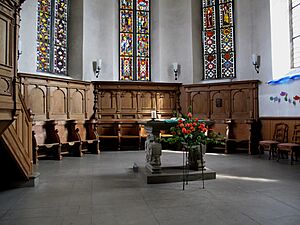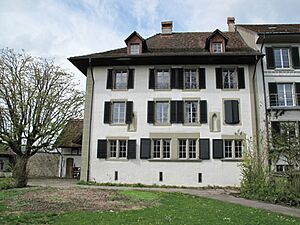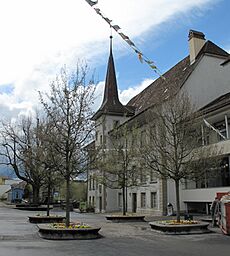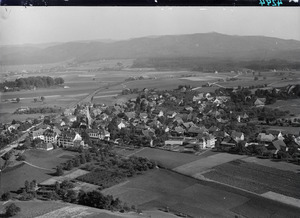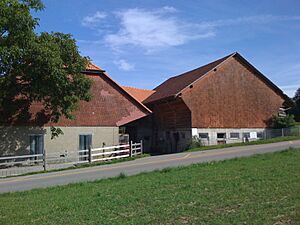Münchenbuchsee facts for kids
Quick facts for kids
Münchenbuchsee
|
||
|---|---|---|
 |
||
|
||
| Country | Switzerland | |
| Canton | Bern | |
| District | Bern-Mittelland | |
| Area | ||
| • Total | 8.81 km2 (3.40 sq mi) | |
| Elevation | 564 m (1,850 ft) | |
| Population
(Dec 2020 )
|
||
| • Total | 10,233 | |
| • Density | 1,161.5/km2 (3,008.3/sq mi) | |
| Postal code |
3053
|
|
| Localities | Hofwil | |
| Surrounded by | Bolligen, Deisswil bei Münchenbuchsee, Diemerswil, Ittigen, Kirchlindach, Moosseedorf, Rapperswil, Schüpfen, Wiggiswil, Zollikofen | |
| Twin towns | Landiswil (Switzerland), Milevsko (Czech Republic) | |
Münchenbuchsee is a town in Switzerland, located in the Bern-Mittelland area of the Bern canton. It's known as the birthplace of the famous painter Paul Klee.
On January 1, 2023, the nearby town of Diemerswil joined with Münchenbuchsee to form a larger municipality.
Contents
History of Münchenbuchsee
Münchenbuchsee was first mentioned in a document in 1180. Back then, it was called Buhse. Even today, people in Swiss German sometimes call it Buchsi.
The oldest signs of people living here are from the neolithic (New Stone Age) and Hallstatt periods. These ancient tools and items were found near Moossee Lake. Some Bronze Age objects were also found in Hofwil. Other discoveries include old earth forts from the Iron Age and High Medieval times at Schwandenberg. There was also a burial mound and an Early Medieval grave found in Hofwilwald.
The Order of St. John
A knight named Kuno von Buchsee gave all his land to the Order of St. John. He did this after returning from his third trip to Jerusalem. The Order of St. John was a group of knights who helped pilgrims and the sick.
They built a commandry here, which was like a headquarters for the order. This commandry grew and gained more land and power in the area. In 1210, the order built a hospice (a place for travelers to rest) and an infirmary (a small hospital). They also built a large kitchen. For over 350 years, the members of the order gave food to the poor twice a week.
Life at the Commandery
The seal of the Münchenbuchsee Commandery was first used in 1264. By 1329, the people living at the Commandery became citizens of Bern. The south side of the courtyard had Kuno's castle, the church, and a place for people to live. The choir (the part of the church where the singers sit) of the Commandery Church was built between 1260 and 1280. The beautiful stained glass windows are from the 13th century.
On the north side of the courtyard, there was a "summer house," a guesthouse, and workshops. The religious community was small. By 1480, only the commander, the prior (a leader), and six brothers lived there. Because of family connections, the Münchenbuchsee Commandery and the Thunstetten Commandery became linked. Sometimes, the prior at Thunstetten would send someone to manage the smaller Münchenbuchsee Commandery.
Changes After the Reformation
During the Protestant Reformation in 1528, Commander Peter Englisberg supported the idea of the church giving up its land to the government. As a reward, he received Bremgarten Castle.
After the Reformation, the State of Bern (which is now the canton of Bern) took over the commandry. They created a Landvogtei there. A Landvogtei was like a local government office, similar to a reeve in England. Between 1600 and 1620, the Landvogtei's Castle and a tithe barn (a barn for storing taxes paid in crops) were built. The bailiff (the person in charge) ruled the village until the French invaded in 1798. This led to the creation of the Helvetic Republic.
In 1803, the village became part of the new Fraubrunnen district.
Rebuilding and Growth
Münchenbuchsee was partly destroyed by a big fire in 1770. Many towns and private groups helped rebuild the village by donating wood, grain, and money. After the fire, the town bought its first fire-engine and hired a night watchman to prevent future fires.
Projects to drain the marshy land around the lake started in 1780. In 1855-56, a construction project lowered the lake's water level, creating new farmland. Another project from 1917-20 drained most of the remaining marsh near the village.
Münchenbuchsee has always been closely connected to the city of Bern. In the 19th and 20th centuries, new transportation links made this connection even stronger. From 1844-46, the main road between Bern and Lyss was built through Münchenbuchsee. Then came the Münchenbuchsee-Zollikofen train station in 1857 and the Münchenbuchsee station in 1864. These stations were part of the new train lines connecting Bern to Olten and then to Biel. In 1916, another train line, the Bern-Solothurn-Zollikofen Railway, built a station in Zollikofen, providing another link.
Münchenbuchsee grew steadily during the 20th century. In 1953, the Allmend district was built near Zollikofen. The Waldegg district followed in the 1960s. Both areas were planned for homes and businesses. Because of many job opportunities and good transportation, the population grew very quickly after 1965.
The many new neighborhoods meant the town needed to improve its services. Two new schools opened, and the old secondary school (built in 1858) was replaced. The Sports Center Hirzenfeld opened in 1982, followed by the Leisure Center in 1985.
A school for deaf and mute students opened in the castle in 1890. It has since grown into the Pedagogic Centre for Hearing and Speech Münchenbuchsee. This school, along with the Sonderschulheim Mätteli (opened in 1967) and the Psychiatric Clinic of Wyss (opened 1845), are very important for the country.
Geography of Münchenbuchsee
Münchenbuchsee covers an area of 8.81 km2 (3.40 sq mi). About 38.8% of this land is used for farming, and 27.2% is covered by forests. The rest, about 34.6%, is used for buildings and roads. A very small part, 0.3%, is rivers or lakes.
Most of the built-up area includes industrial buildings (4.2%), houses and other buildings (13.7%), and transportation like roads and railways (7.8%). Parks and sports fields make up 7.7%. All the forested land is covered with thick forests. For farming, 30.4% is used for crops, 7.1% for pastures, and 1.2% for orchards. All the water in the town is flowing water, like rivers.
Münchenbuchsee is about 10 kilometers (6 miles) northwest of Bern. It is located on the main route between Bern and Biel. The town sits on the southern shore of the Moossee Lake. It includes the main village of Münchenbuchsee and the smaller settlement of Hofwil. One of Switzerland's five schools for people with hearing difficulties is located here.
On December 31, 2009, the old district of Fraubrunnen, where Münchenbuchsee belonged, was closed. The next day, January 1, 2010, Münchenbuchsee became part of the new Bern-Mittelland administrative district.
Münchenbuchsee Coat of Arms
The blazon (description) of Münchenbuchsee's municipal coat of arms is: Gules on a Bend Argent nine Box Leaves Vert. This means it has a red background, with a silver band going across it, and on that band are nine green box leaves.
People of Münchenbuchsee (Demographics)
Münchenbuchsee has a population of 10,233 (as of December 2020[update]). As of 2010, about 13.8% of the people living here were foreign nationals. Over the past 10 years (2000–2010), the population grew by 5.6%. This growth was mainly due to more births than deaths.
Most people (about 88.9% as of 2000) speak German as their first language. Italian is the second most common language (2.0%), followed by French (1.5%).
As of 2008, about 48.9% of the population was male and 51.1% was female. About 20.3% of the people in the town were born in Münchenbuchsee. Another 44.3% were born in the same canton (Bern), while 17.2% were born elsewhere in Switzerland. About 14.6% were born outside of Switzerland.
As of 2010, children and teenagers (ages 0–19) make up 21.9% of the population. Adults (ages 20–64) make up 62.3%, and seniors (over 64) make up 15.8%.
In 2000, there were 4,106 single people who had never been married. There were 4,630 married people, 400 widows or widowers, and 473 divorced people.
Also in 2000, there were 1,250 homes with only one person living in them, and 216 homes with five or more people. Most apartments (92.8%) were lived in all the time. Only a small number were used seasonally (5.3%) or were empty (1.9%). In 2011, about 1.17% of apartments were empty.
The chart below shows how the population has changed over time:

Important Heritage Sites
The swimming pool at Hofwil, the Hofwil Institution, and Hofwil Castle are all very important historical places in Switzerland. They are listed as heritage sites of national significance. The whole area around Hofwil is also part of the Inventory of Swiss Heritage Sites.
Hofwil Institution
The Hofwil Institution was built by Philipp Emanuel von Fellenberg, a rich man from Bern. In 1798, he took over the Hofwyl estate and turned it into several schools. His goal was to educate people from all walks of life. He started a school for poor children, a secondary school for local students, and a special institute for the sons of wealthy families from all over Europe.
The Hofwil Institution building was constructed between 1817 and 1821. It was the main part of Fellenberg's educational plan. Other buildings, like outbuildings and a teacher's house, were added soon after. In 1884, the Canton of Bern bought the building to create a college for teachers. After many updates, in 1970, the building became a music institute for students in grades 10 through 12. It also has an optional boarding school for students who want to live there.
Hofwil Castle
Hofwil Castle was built between 1784 and 1786 by an architect named Carl Ahasver von Sinner. It was built for Gabriel Albrecht von Erlach. In 1798, a peristyle (a row of columns around a building) was added to this neo-classical style building.
Economy of Münchenbuchsee
In 2011, Münchenbuchsee had a low unemployment rate of 1.9%. As of 2008, there were 5,217 people working in the town.
Types of Jobs
- Primary Sector: About 50 people worked in the primary economic sector, which includes farming and forestry. There were about 10 businesses in this area.
- Secondary Sector: 1,361 people worked in the secondary sector. This includes manufacturing (making things) and construction (building things). There were 74 businesses in this sector.
- Tertiary Sector: The largest group, 3,806 people, worked in the tertiary sector. This involves services, like shops, hospitals, and schools. There were 287 businesses in this sector.
In 2008, there were 4,402 full-time equivalent jobs. This means if you add up all the hours worked by full-time and part-time employees, it equals this many full-time jobs.
Many jobs in the tertiary sector involved sales, transportation, hotels, restaurants, and health care. For example, 997 jobs were in sales or car repair, and 532 were in health care.
Commuting
In 2000, 2,568 workers came into Münchenbuchsee for their jobs, while 3,876 workers left the town to work elsewhere. This means more people leave Münchenbuchsee to work than come in. About 37.2% of working people used public transportation to get to work, and 40.5% used a private car.
Religion in Münchenbuchsee
Based on the 2000 census:
- 17.1% of people were Roman Catholic.
- 60.7% belonged to the Swiss Reformed Church (a Protestant church).
- About 2.37% were members of an Orthodox church.
- A small number (0.04%) belonged to the Christian Catholic Church of Switzerland.
- About 8.28% belonged to other Christian churches.
- There was 1 person who was Jewish.
- About 4.00% of the population was Islamic.
- 39 people were Buddhist.
- 52 people were Hindu.
- 16 people belonged to other religions.
- About 7.11% of the population did not belong to any church, or were agnostic (not sure about God) or atheist (do not believe in God).
- 3.35% did not answer the question about their religion.
Education in Münchenbuchsee
In Münchenbuchsee, about 4,044 people (42.1%) have finished non-mandatory upper secondary education. This means they went beyond the basic required schooling. Also, 1,280 people (13.3%) have completed higher education, like attending a university or a specialized college (called a Fachhochschule).
Swiss School System
The school system in the Canton of Bern works like this:
- One year of non-required Kindergarten.
- Six years of Primary school.
- Three years of required lower Secondary school, where students are grouped by their abilities.
- After lower Secondary, students can choose to continue their education or start an apprenticeship (learning a trade on the job).
Student Numbers (2010–2011)
During the 2010–11 school year, 1,411 students attended classes in Münchenbuchsee.
- There were 15 kindergarten classes with 205 students. About 19.0% of these students were not Swiss citizens, and 31.7% spoke a different language at home than the classroom language.
- The town had 32 primary classes with 603 students. About 16.3% of these students were not Swiss citizens, and 28.0% had a different home language.
- There were 22 lower secondary classes with 418 students. About 13.2% were not Swiss citizens, and 18.4% had a different home language.
In 2000, 420 students came to Münchenbuchsee schools from other towns, while 270 students from Münchenbuchsee went to schools outside the town.
Climate in Münchenbuchsee
Münchenbuchsee has a Marine West Coast climate, which means it has mild temperatures and rain throughout the year. The average yearly temperature is about 7 degrees Celsius (44 degrees Fahrenheit).
The coldest month is usually January, with an average temperature of -3 degrees Celsius (26 degrees Fahrenheit). The warmest month is July, with an average temperature of 18 degrees Celsius (64 degrees Fahrenheit).
The wettest month is August, with about 102 millimeters (4 inches) of rain or snow. The driest month is February, with about 58 millimeters (2.3 inches) of precipitation.
| Climate data for Munchenbuchsee | |||||||||||||
|---|---|---|---|---|---|---|---|---|---|---|---|---|---|
| Month | Jan | Feb | Mar | Apr | May | Jun | Jul | Aug | Sep | Oct | Nov | Dec | Year |
| Daily mean °C (°F) | −3 (26) |
0 (32) |
3 (37) |
8 (46) |
12 (53) |
16 (60) |
18 (64) |
16 (60) |
13 (55) |
8 (46) |
2 (35) |
0 (32) |
7 (44) |
| Average precipitation mm (inches) | 69 (2.7) |
58 (2.3) |
64 (2.5) |
66 (2.6) |
81 (3.2) |
99 (3.9) |
89 (3.5) |
100 (4) |
89 (3.5) |
81 (3.2) |
84 (3.3) |
76 (3) |
960 (37.7) |
Notable People from Münchenbuchsee
- Heinrich Morf (1854–1921), a Swiss expert in languages and literature.
- Paul Klee (1879–1940), a famous Swiss-German artist whose work was influenced by expressionism, cubism, and surrealism.
- Otto Schneider-Orelli (1880–1965), a Swiss entomologist (someone who studies insects).
- Stephan Eicher (born 1960), a Swiss post-punk and pop music singer.
See also
 In Spanish: Münchenbuchsee para niños
In Spanish: Münchenbuchsee para niños





